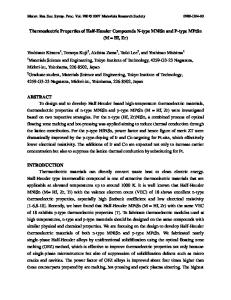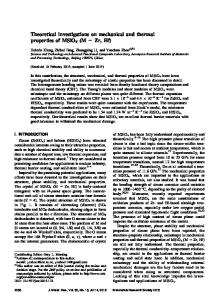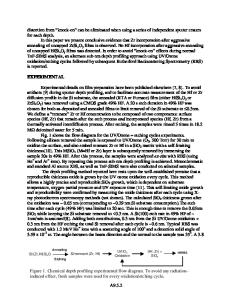Phase stability and thermoelectric properties of half-Heusler compounds (Ti,M)NiSn (M = Zr, Hf)
- PDF / 904,260 Bytes
- 6 Pages / 612 x 792 pts (letter) Page_size
- 87 Downloads / 481 Views
1218-Z05-14
Phase stability and thermoelectric properties of half-Heusler compounds (Ti,M)NiSn (M = Zr, Hf) Takahiro Kenjo, Yoshisato Kimura and Yoshinao Mishima Tokyo Institute of Technology, Interdisciplinary Graduate School of Science and Engineering, Department of Materials Science and Engineering, 4259-G3-23 Nagatsuta, Midori-ku, Yokohama 226-8502, Japan ABSTRACT Aiming to improve thermoelectric properties of half-Heusler compounds MNiSn (M = Ti, Zr, Hf), phase equilibria in the (Ti,M)NiSn systems have been investigated focusing on the halfHeusler phase separation between TiNiSn and ZrNiSn and TiNiSn and HfNiSn. Solubility limit of an element M in each half-Heusler phase was determined by XRD and EPMA. Nearly single phase alloys were fabricated by the directional solidification using optical floating zone melting method to evaluate intrinsic thermoelectric properties of the alloys. Lattice thermal conductivity can be reduced in (Ti,M)NiSn alloys by phonon scattering due to the solid solution effect of M site substitution. Moreover, electrical properties can be enhanced by the Ti addition in (Ti,Zr)NiSn alloys. Among present MNiSn alloys, (Ti0.15,Zr0.85)NiSn alloy has the highest power factor of 5.3 mWm-1K-2 at around 745 K. INTRODUCTION Thermoelectric materials play a key role in conserving energy and preserving the global environment. We are focusing on half-Heusler compounds MNiSn (M = Ti, Zr, Hf) [1-9], wellknown as excellent n-type thermoelectric materials composed of nontoxic elements, which can be used at around 1000 K to directly convert waste heat into clean electrical power. Thermoelectric performance of a material is evaluated by the dimensionless figure of merit ZT = (S2/ρκ)Τ, where S is Seebeck coefficient, ρ is electrical resistivity, κ is the total thermal conductivity which is comprised of the electronic and lattice contributions (κ = κcar + κlat), and T is absolute temperature. Advantages of MNiSn alloys are excellent electrical properties, i.e., large Seebeck coefficient and low electrical resistivity. On the other hand, relatively high thermal conduction is a disadvantage. We have prepared single phase alloys using the directional solidification by the optical floating zone (OFZ) melting method to evaluate the intrinsic performance of half-Heusler phases [2-5]. The lattice thermal conductivity is expected to be reduced by substituting M site elements between Ti, Zr and Hf, which is called as the solid solution effect since the differences in atomic mass and atomic size in the solid solution phase effectively enhance phonon scattering [10]. In fact, we have confirmed that the substitution of Zr for Hf on M site reduces the thermal conductivity for nearly single phase (Zr0.5,Hf0.5)NiSn alloy [2]. Since the differences in atomic mass and atomic size between Ti and M are larger than those between Zr and Hf, it is also expected that the thermal conductivity of (Ti,M)NiSn alloys is substantially reduced by the solid solution effect. However, we have observed two phase microstructure in (Ti0.5,M0.5)
Data Loading...











